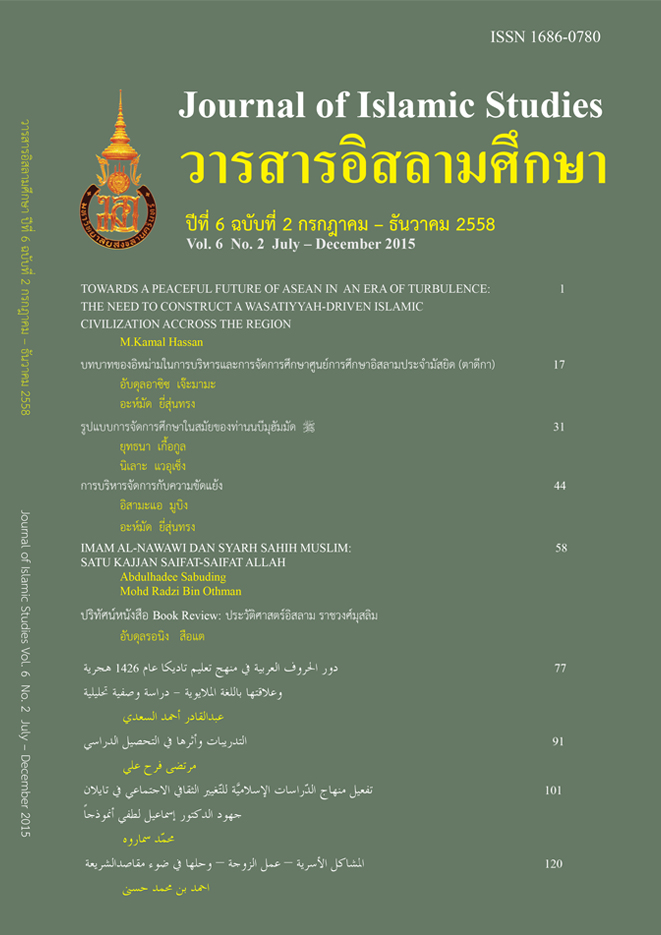Imam Al-Nawawi dan Syarh Sahih Muslim: Satu Kajian Sifat-Sifat Allah
คำสำคัญ:
Imam Nawawi, Sifat Sifat Allahบทคัดย่อ
Kajian ini bertujuan untuk mengkaji riwayat hidup imām al-Nawawī, mengenal pasti alirannya mengenai sifat-sifat Allah, metodologi dalam menghuraikan hadīth-hadīth sifat dalam kitab SyarhSahīh Muslim. Kajian ini adalah kajian kepustakaan dengan mengumpulkan data-data daripada sumber primer dan sekunder. Analisis data berbentuk deskriptif dengan menggunakan dua kaedah utama iaitu kaedah deduktif dan induktif.
Dapatan kajian menunjukkan bahawa Imām al-Nawawī adalah salah seorang ulamā’ bermazhab al-Asyāfi‘iy dari segi fiqh dan Asy‘ari di segi ‘aqīdah. Beliau lebih dikenali oleh masyarakat Islām sebagai ulamā’ hadīth, disebabkan beliau mempunyai ilmu mendalam dan kepakaran dalam beberapa bidang seperti: Mustalah, Lughah dan Tarājim. Beliau juga banyak menghasilkan karya ilmiah dalam berbagai bidang terutama SyarhSahīh Muslim. Beliau menghuraikan hadīth-hadīth sifat mengenai ‘aqīdah berdasarkan metode campuran dua aliran iaitu salaf dan khalaftetapi dengan memberi penekanan kepada aliran khalaf.Beliau kemukakan nas - nas yang dipetikan dari rujukan aliran khalaf secara khusus terutama al-Māziriy dan al-Qādī ‘Iyād tanpa sebarang komen. Terdapat beberapa fakta yang mendorongkan beliau beraliran khalaf yang paling penting ialah peranan madrasah, dukungan daripada kerajaan, ulamā’khalaf menyokong kerajaan, aliran al-Asyā‘irah sebagai aliran rasmi kerajaan, masyarakat umum beraliran khalaf dan bahan-bahan rujukan beraliran khalaf.
เอกสารอ้างอิง
Ibn Hajar, Ahmad bin Alī bin Hajaral-‘Asqallāniy(1995a). Taqr̅ib al-Tahdh̅ib, Bairu̅t: Dār al- Fikr.
Masyhur bin Hasan al-Sulaimān(1993). al-Rudud wa al-Ta‘aqubāt ‘alā mā waqaa‘ li Imām al-Nawāwi fī Syarh̟ Sahih Muslim min al-Ta’wīl fī al-Sifāt wa Ghairiha min Masāal al- Muhimmāt, al-Riyādh: Dār al- Hijrah.
al-Māziriy, Muhammad bin ‘Alī (1988). al-Mu‘lim bi Fawā’id Muslim, Tunis: Dār al-Tunisiyyah.
Muslim bin al-Hajjāj(1995). Saḥīḥ Muslim Syarḥ al-Nawawī, Bairūt: Dār al-Ma‘rifah.
Mustafā Hilmī(2005). Manhaj Ulamā’ al-Hadīth wa al-Sunnah fī Usūluddīn, Bairūt: Dār al-Kutub al-Ilmiyah.
al-Nawawī, Yahyā bin Syaraf (1995). Sahih Muslim bi Syarh Imām Muhy al- Dīn al-Nawawī, Bairūt: Dār al- Ma‘rifah.
al-Qāsimiy, Muhammad Jamāl al-Dīn(1979). Qawā‘id al-Tahdīth min Funūn Musthalah al- Hadīth, Bairūt: Dār al- Kutub al-Ilmiyyah.
al-Sakhāwiy, Muhammad bin ‘Abd al-Rahmān bin Abī Bakr(t.t). Tarjamah Syeikh
al-Islām Abī Zakariya Yahyā al- Nawawī, Misr: Makhthūthāt al-Azhar al-Syarīf.
al-Syahrastāniy, Muhammad bin ‘Abd al-Karīm(1997).al-Milal wa al-Nihal, Bairūt: Dār al- Ma‘rifah.
ดาวน์โหลด
เผยแพร่แล้ว
รูปแบบการอ้างอิง
ฉบับ
ประเภทบทความ
สัญญาอนุญาต
บทความทุกเรื่อง ที่ได้รับการตีพิมพ์ในวารสารอิสลามศึกษาเป็นแนวคิดของผู้เขียน มิใช่เป็นความคิดเห็นคณะผู้จัดทำและมิใช่ความรับผิดชอบของคณะวิทยาการอิสลาม กองบรรณาธิการไม่สงวนสิทธิ์การคัดลอก แต่ให้มีการอ้างอิงแสดงที่มา




